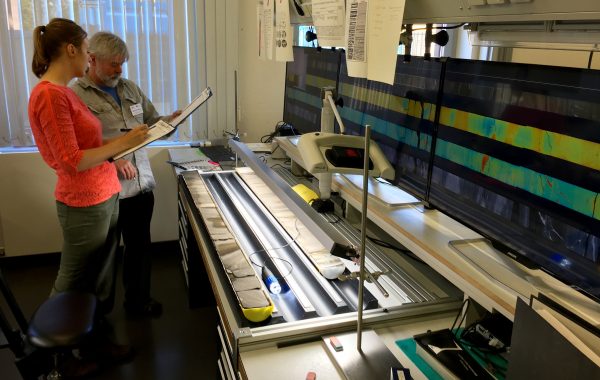Life recovered quickly after asteroid impact that killed dinosaurs
May 30, 2018
Sue Mitchell
907-474-5823

Life returned to the asteroid-blasted Chicxulub crater much sooner than at some other sites far from the impact point 66 million years ago, according to a University of Alaska Fairbanks scientist and fellow researchers.
UAF Geophysical Institute professor Michael Whalen studied a core drilled about 4,500 feet below the crater, offshore of Mexico's Yucatan Peninsula.
Whalen and colleagues, led by Christopher Lowery at the University of Texas Institute for Geophysics, reported on their study in an article published May 30 in the journal Nature.
Their evidence shows that life returned to the Chicxulub crater only two to three years after the asteroid's impact. Whalen found ovals made by burrowing worms in the uppermost impact-related sediments.
By 30,000 years after impact, a thriving ecosystem was present in the crater, with microscopic plants supporting a diverse community of organisms in the surface waters and on the seafloor.
In contrast, other areas around the world, including the North Atlantic and other parts of the Gulf of Mexico, took up to 300,000 years to recover in a similar manner. The scientists said local factors, such as water circulation, organism interactions and the availability of ecological niches, would have influenced a particular ecosystem’s recovery rate.
An asteroid impact created the crater about 66 million years ago. The asteroid was about 9 miles in diameter, and it made a crater about 125 miles across. The impact killed 75 percent of life on Earth, including most of the dinosaurs, and marked the beginning of a new era in geological history.
“The impact crater is very well preserved because it sat there with carbonate sediments being deposited on top of it ever since the impact occurred,” Whalen said. “And so it’s one of the best-preserved impact craters on Earth. It was one of the reasons we picked it to do these studies, to get a better understanding of the return of life after the impact event.”
Whalen studied a core collected by the International Ocean Discovery Program and International Continental Drilling Program in 2016. Whalen, who specializes in limestone sedimentary rocks and their fossils, led the visual core description team for the sedimentary part of the core. He was interested mostly in the upper 1,050 feet, representing the marine sediments deposited after the impact.
“We found evidence of bioturbation within the uppermost part of that unit, indicating very, very quick return of life to the crater,” said Whalen.
The evidence showed a much quicker recovery of life than at other sites around the world. That undermines a theory that recovery at sites closest to a crater would be the slowest because of environmental contaminants such as toxic metals released by the impact. Instead, the evidence suggests that recovery around the world was influenced primarily by local factors, which could have implications for environments affected by climate change today.
“The impact at the Cretaceous-Paleogene boundary is one of the most amazing events in Earth’s history,” Whalen said. “It basically changed the entire ecosystem to the point where we lost a lot of various organisms both on the oceans and on the land.”
The IODP, ICDP, National Science Foundation and NASA funded the research.

ADDITIONAL CONTACTS: Michael Whalen, 907-474-5302, mtwhalen@alaska.edu; Christopher Lowery, 804-837-3391, cmlowery@utexas.edu
ON THE WEB: http://dx.doi.org/10.1038/s41586-018-0163-6


